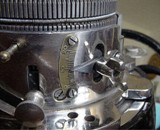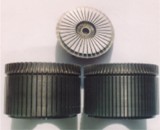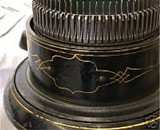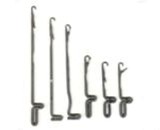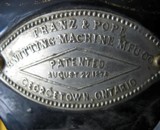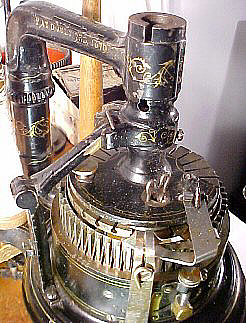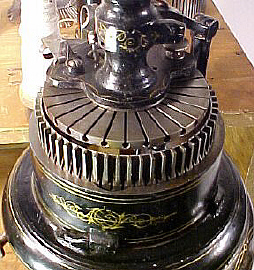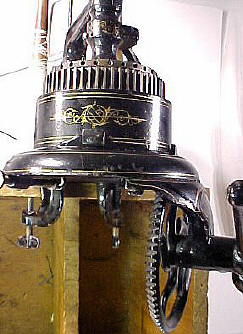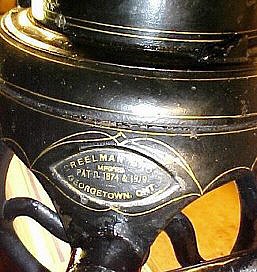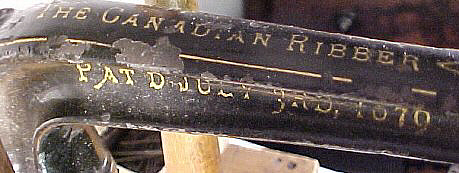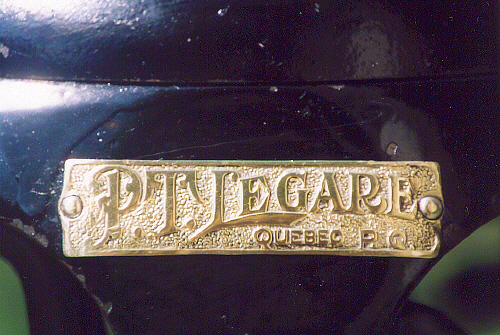|
Oldtymestockings Canadian Sock Machine Museum |
|
|
|
Creelman Brothers' 6 Inch
Circular Knitting Machine
Creelman's 6 inch circular
knitting machines were designed to knit clothing for the
entire family. With Creelman's 6 inch ribber dials and
cylinders, infant jumpers, children's sweaters, ladies'
vests, men's long underwear and a host of other knitted
items could be efficiently and easily knit for the family
and common market. Note the ribber dial and cylinder comparisons of Creelman's
standard 4½ and specialty 6 inch sock machines. Creelman's 6
inch circular knitting machines came standard with 24/72 and
50/100 combinations. |
|
|
|
Creelman Brothers' Banner Knitting Machine
This Canadian sock machine was
the Creelman Brothers' finest. The crescent shaped,
automatic needle latch opener was a standard accessory on
the Banner and World Star Sock machines. Manufactured
in the 1800s, a complete outfit included a 36 slot ribber
dial, a 40 slot ribber dial and 60, 72 and 80 slot cylinders.
Cost was $100.00 back then......imagine that!
|
|
|
|
Creelman Brothers' Conical
Industrial Knitting Machine
The Creelman Brothers' conical
knitting machines were manufactured for industrial use.
Aside from factories and industries, schools for the blind,
children's homes and workhouses acquired industrial knitting
machines for trade. Most industrial sock machines were
operated via the use of large, leather drive belts and industrial
strength motors. A full-length sock could be produced
in a matter of minutes. |
|
|
|
Creelman Brothers' Money Maker A
Knitting Machine
This Canadian sock knitting
machine parallels the Legare 400 sock machine in
design. A typical setup included a 36 slot ribber dial, 54
slot cylinder and 72 slot cylinder. However,
additional combinations were also available.
Parts such as tappet plates,
yarn carriers and cam shells were virtually identical to the
Legare 400 sock machines. One noteworthy difference is the ribber drive pin. Creelman's pin is straight and has
numbers etched in the head. The switch pin, unlike the Legare sock machines,
has a distinctive shape and is composed of steel, not brass. A final variant is
the design of the crank wheel. It features Creelman's
characteristic hub and lacks openings. |
|
|
|
Creelman Brothers' New K Power
Industrial Knitting Machine
The Creelman Brothers produced a
host of machines for private and commercial use. The
New K Power knitting machine was designed for "special
work". It was advertised by the Creelman Brothers as
the best knitting machine for the manufacture of ribbed,
seamless hosiery.
Although an industrial
knitting machine, like Creelman's domestic sock machines,
the New K Power knitting machine utilised
flat ribber dials instead of conical ribber dials. Robust leather belts
and powerful steam motors enabled the production of socks in
a matter of minutes. |
|
|
| |
|
Creelman Brothers' Old World Star Knitting
Machine - under construction |
|
|
|
Creelman Brothers' Original World Star
Ribbing Machine
Patented in 1879 as "The Great Hosiery and
Family Ribber", this sock machine was the Creelman Brothers'
first ribbing machine. Creelman's plain machine did not
feature a ribbing attachment and was patented the 22nd of
August, 1874.
|
|
|
|
Harley Kay Industrial Knitting
Machine The
Harley Kay circular knitting machine was an industrial sock
machine manufactured in Georgetown Ontario in the 1940s by the Harley Kay
company. Harley Kay sock machines
were established in Canadian factories to produce hosiery
upon demand. Although individual stands were
available, due to their tremendous weight, Harley Kay
sock machines were generally mounted to wooden platforms or steel
tables. Harley Kay sock machines came standard with
higher slot combinations of 36/72, 42/84 and 60/120. |
|
|
|
Machine à Tricoter Knitting Machine
Manufactured by the Creelman Brothers, this Canadian sock
machine shows a marked resemblance to the Creelman Brothers'
World Star sock machine. Both models featured a
crescent-shaped needle latch opener with yarn feeding
through the centre ribber post. P. T. Legare was
believed to be a firm that sold goods via mail order
catalogue.
|
|
|
|
New
Improved Canadian Automatic Knitting Machine
A late edition, the New
Improved Canadian Automatic sock machine was a novelty item
for special customers. Parts such as tappet plates, yarn
carriers and yarn stands were made of solid brass. Due to
cost expenditures, brass sock machines were rarely produced. |
|
|
| P. T. Legare
3½ Circular Knitting Machine
Created for the construction of
infant and children's socks, P. T. Legare's 3½ diameter sock
machines came standard with 36 slot ribber dials and a 72
slot cylinders. Other combinations such as 28/56, 30/60
and 50/100 were also available. Noteworthy to mention,
infant and children's socks can be easily knit on P. T. Legare's standard 4½ diameter sock machines. Indeed,
all instruction manuals for standard 4½ diameter sock
machines have detailed patterns on the construction of
infant and children's hosiery. |
|
|
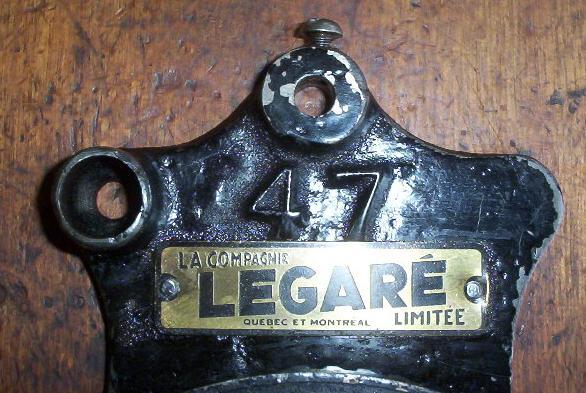 |
|
P. T. Legare 47 Circular
Knitting Machine
The P. T. Legare 47 sock machine
was manufactured by the Creelman company. Its design
was much simpler than Creelman's 400 series sock machines.
In particular, the cylinder
tension dials of the P. T. Legare 47 sock machines were
enclosed in the cam shell. Contrariwise, the cylinder
tension dials of Creelman's 400 series sock machines were
constructed separately and readily detachable.
Furthermore, the control plate centre cams were omitted from
the P. T. Legare 47 tappet plates, whilst the 400 series
sock machines had steel control plate centre cams.
The less number of machine
parts and simplicity of design allowed the Creelman firm to
produce the P. T. Legare 47 sock machines at a cost
less than their 400 series counterparts. Noteworthy to
mention, the advertising of the 47 series sock machines was
virtually absent from Creelman's brochures, catalogues and
leaflets. P. T. Legare 47 sock
machines came standard with a 36/54/72 ribber dial and
cylinder combination. |
|
|
|
P. T . Legare 400 Circular
Knitting Machine
P. T. Legare 400 sock machines were
manufactured by the Creelman Brothers. The overall
design is analogous to Creelman's 400 series sock machines.
Despite the numerous similarities, the Creelman Brothers
routinely advertised in brochures, catalogues, leaflets and instruction
manuals that the Creelman Brothers' sock machines were the
best in the trade.
P. T. Legare 400 sock
machines came standard with a 36 slot ribber dial, 54 slot
cylinder and 72 slot cylinder. Notwithstanding, Creelman's 400 series sock machines were available in
13
different ribber dial and cylinder combinations. These
included 24/48, 28/56, 30/60, 32/64, 34/68, 36/72, 38/76,
40/80, 42/84, 44/88, 46/92, 48/96 and 50/100. Both of
the P. T. Legare and Creelman sock machines were constructed
of cast iron, steel and brass. |
|
|
| P. T . Legare World
Star Knitting Machine
Grand and impressive, this
Canadian sock machine resembles the Creelman Brothers'
"Star", "New Star" and "World Star" sock machines in
appearance. Much like the Creelman Brothers' sock machines,
ribber dials ranged between 28 and 50+ slots,
whilst cylinders held
48 to 100+ slots. Aside from label variations, Creelman's
initial design of these large sock machines remained
unchanged. |
|
|
|
Verdun
Semi-Automatic Knitting Machine
The Verdun
Semi-Automatic knitting machine was designed for industrial
use. Features include a lever that raises cylinder
needles out of working position at commencement of the heel
or toe. Similarly, whilst knitting heels and toes, a
switch pin automatically raises cylinder needles out of work.
These aspects allowed the industrial worker to manage
several knitting machines at once. Verdun
Semi-Automatic knitting machines came standard with 36/72
and 42/84 combinations. |
|
|
